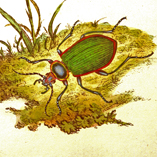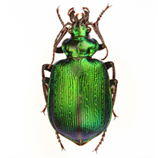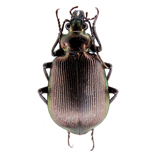Systematic Framework
 It is not immediate what is meant by the term Calosoma. As a matter of fact, in order to define an appropriate term describing all the known species in an unambiguous way, it is necessary a quite long premise.
It is not immediate what is meant by the term Calosoma. As a matter of fact, in order to define an appropriate term describing all the known species in an unambiguous way, it is necessary a quite long premise.
According to Jeannel (1941), the French entomologist to whom we also owe a fundamental monograph on the Calosoma, the Caraboidea (corresponding to the family Carabidae in the previous authors) should be divided into several families, one of which is the family Carabidae, that includes the subfamilies of Carabitae and Cychritae. In Carabitae there are the tribes of Calosomini and Carabini.
According to the most widespread interpretation, taken up by Lindroth (1961-69) and currently shared by the majority of scholars, Carabidae should be regarded as a family of Coleoptera and should be divided into several subfamilies, one of which is the subfamily Carabinae that is composed of the tribes Carabini, Cychrini, Pamborini, and Ceroglossini. In Carabini the sub-tribes Calosomatina (this being the correct spelling of the sub-tribe name according to the International Code of Zoological Nomenclature, 1999, art. 29.3.1) and Carabina are included together, thus accentuating their interrelation. In a still more radical vision, applied in the catalogue of Lorenz (2005) all the genera or sub-genera previously included in Calosomatina and Carabina are found together inside the sub-tribe Carabina.
At the moment, the interpretation that considers Calosomatina as a sub-tribe of Carabini appears the most acceptable, in the light of the research findings of the latest genetic studies, that demonstrate that Calosomatina is a derived lineage in the evolution of Carabinae. possibly a sister group to Carabina (Su et al., 2005: 148).
This conclusion contradicts the hypothesis of Jeannel, who believed that the Calosoma dated back to the Jurassic period and they had later given rise to the Carabus and Ceroglossus lines in the tertiary ere.
Jeannel had also proposed a subdivision of his Calosomini (or for us Calosomatina) into phyletic series which included genera linked by phylogenetic relationships explained in light of hypotheses of paleo-biogeography (Pangean progressive fragmentation).
According to the results of the genetic studies the split between Carabina and Calosomatina would have occurred in the late Cretaceous (Toussaint & Gillett 2017:14) or even much later in the early Oligocene (Su et al., 2005: 149). Thereforer, the diversification of lineages cannot be explained through the geological events evoked byJeannel which instead occurred in earlier times. However, according to the same genetic studies, the phyletic series probably have a certain degree of validity as they could be interpreted today as clades (Toussaint & Gillett 2017:10).
As for the criteria to define further subdivision inside Calosomatina, Jeannel (1940) transformed the 38 sub-genera previously described into 19 genera (or 20 if we include Aplothorax ) some of which are further subdivided into sub-genera for a total of 32 groups.
Gidaspow (1959: 231), as part of the American fauna, recognized only two genera: Calosoma and Callisthenes, maintaining the other genera of Jeannel as sub-genera. In the already cited catalogue of Lorenz (2005), inside Carabina, five separate genera are seen as valid: Calosoma, Calopachys, Carabops, Carabomorphus and Callisthenes.
In the most recent catalog of Löbl & Löbl (2017) the sub-genera of Calosoma are eliminated and informal taxa designated as "species groups" are recognized (Häckel, 2017: 1-2). These in part, coincides with the sub-genera of previous authors. This approach already followed by Lindroth (1961: 42), when he was dealing with the Canadian fauna, is justified by the likely paraphyly / polyphyly of many groups based on morphological characters which in the light of the results of the above cited genetic analysis would seem homoplasious ones.
As far as we are concerned, as already observed by various authors (Deuve T., Illustrated Catalogue of Genus Carabus of the World (Coleoptera Carabidae) , Pensoft, Sofia-Moscow, 2004; 63; Turin H., Penev L., Casale A., The Genus Carabus In Europe - A Synthesis, Pensoft, Sofia, 2003: 74) when dealing with the the genus Carabus, the rejection of the existing sub-genera because paraphyletic, would lead to further subdivide them in much more sub-genera or species groups, containing few species or monospecific.
This systematic arrangement would be moreover based on analysis not yet definitive, so the Jeannel's system can still be useful, albeit avoiding of accentuating the emphasis on species diversification processes. Consequently it would be better maintaining for the time being the systematic of Calosomatina supported by the approach of Jeannel, tackling his genera as sub-genera of the genus Calosoma, that in its turn is included in the sub-tribe Calosomatina (here we do not deal with the question of systematic position of Aplothorax).
The sub-genera of Calosoma we propose are based on the genera of Jeannel (1940) with minor changes that will be discussed on a case by case basis. They can be considered as homogenous groups, at least from the morphological point of view, and geographically well defined, particularly usefull as the genetic studies do not yet allow to define sufficiently robust phylogenetic alternative hypotheses.
Concerning the species we take a more conservative approach, reducing drastically their number. In fact Jeannel, seventy years ago, recognized 138 species, and in the latest catalogue by Lorenz (2005), there are 168 species, 21 of which have been described after 1940 and the others resulting from the revaluation of previously described taxa. Here we have agreed on 128 species and we think that for most species it is not necessary to distinguish populations and therefore to establish any subspecific level (with few interesting exceptions), while, in some cases, the individual variability within a given population can be very striking.

